Implant supported restorations can be attached to implants with screws or can be cemented to abutments which are secured to implants with screws. Screw-retained prostheses have a well-documented history of successful application in completely edentulous patients [1]. In the areas of limited interridge space, a screw is more effective because abutment lacks the factors of height and surface area. Screw–retained, implant-supported crowns produce tighter margins [2]. However, due to the absence of passive fit of screw-retained superstructures there is greater stress concentration around the implants [1].
To overcome the limitations of screw-retained prostheses, cement-retained prosthesis have become the restoration of choice for the treatment of implant patients. Cemented prosthesis has superior occlusion, aesthetics and loading characteristics when compared with screw-retained prosthesis [3].
The study aimed to assess and compare the retention of base metal crowns cemented to implant abutments with five cements i.e. zinc phosphate, resin modified glass ionomer cement, resin cement, non-eugenol acrylic based temporary implant cement & non-eugenol temporary resin cement [Table/Fig-1].
Materials and Methods
The study was conducted in Sri Guru Ram Das Institute of Dental Sciences & Research, Amritsar for a period of one year (2013-2014). The retention test were performed in CIPET (Central Institute of Plastic Engineering and Technology), Amritsar, India.
In the present invitro study, five epoxy resin edentulous maxillary casts were fabricated. An acrylic resin model of edentulous maxilla was used to form a mold for fabricating epoxy resin cast. Epoxy resin (Araldite CY 230-1 IN, India) was mixed with the hardner (Hunstsman advanced materials LLC, USA, Aradur HY 951, India) in ratio of 10:1 as recommended by the manufacturer. The mixture was poured into the mold and allowed to set at room temperature. After 24 hours, the epoxy resin cast was obtained, finished and polished. The holes for implant analogs were milled in all the five epoxy resin casts, perpendicular to the plane of cast in right first molar and left first molar region with help of milling machine (CNC Milling machine, model no. UME-600, Mikron) [Table/Fig-2] and implant analogs (Internal hex, Adin dental implant systems ltd, Israel) were secured with help of clear autopolymerizing acrylic resin (Rapid Repair, Pyrex, India) [Table/Fig-3]. The implant abutments (Adin dental implant systems Ltd, Israel, 4mm in diameter and 11mm height) were screwed into all the analogs with help of hex driver (Adin dental implant systems ltd, Israel) [Table/Fig-4] and torqued to 30N cm with torque wrench. Total of 20 metal crowns (ten on left implant analog and ten on the right implant analog in the first molar region) were fabricated on each epoxy resin cast and total being 100.
Milling of epoxy resin casts.
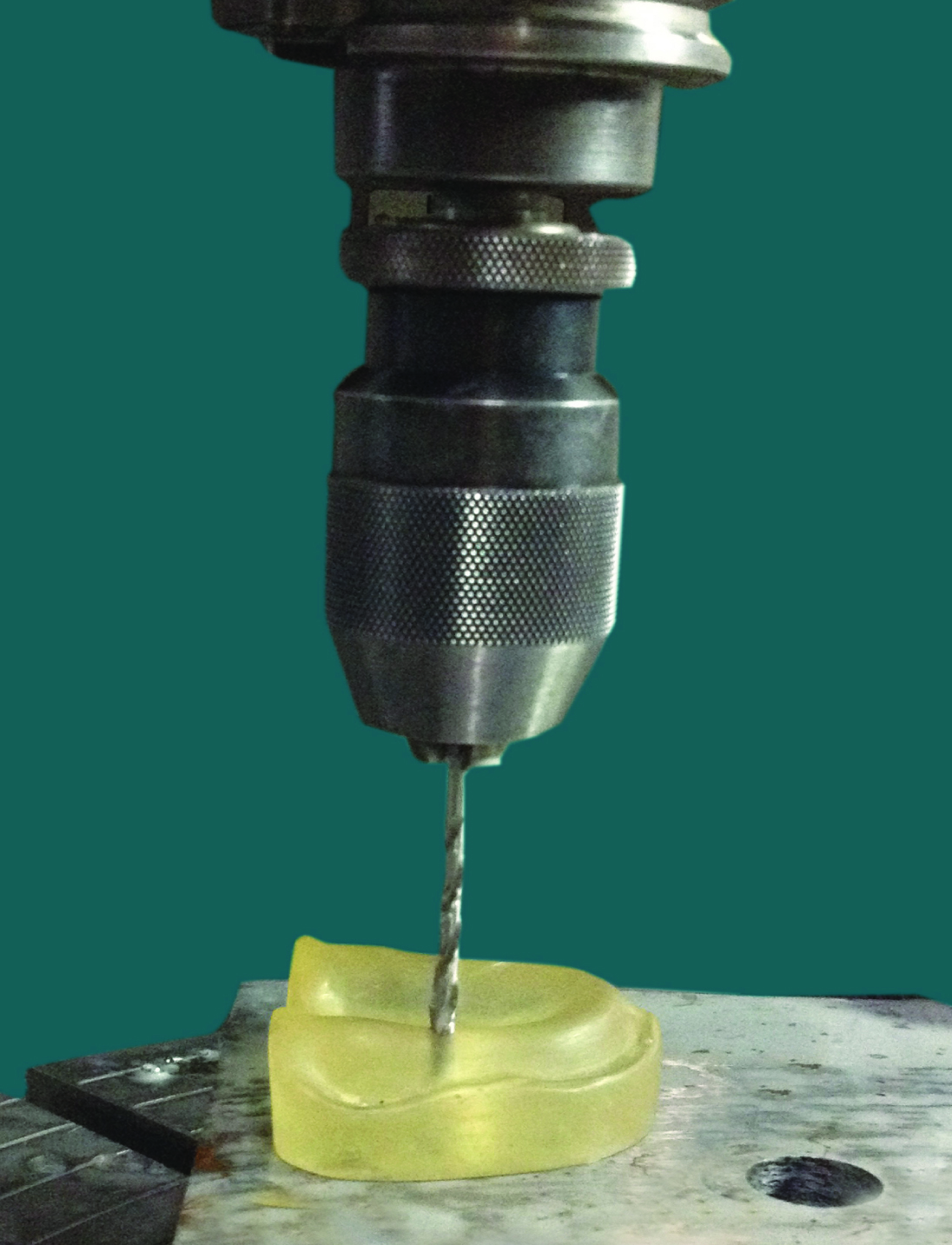
Implant analogs secured with help of autopolymerising acrylic resin.
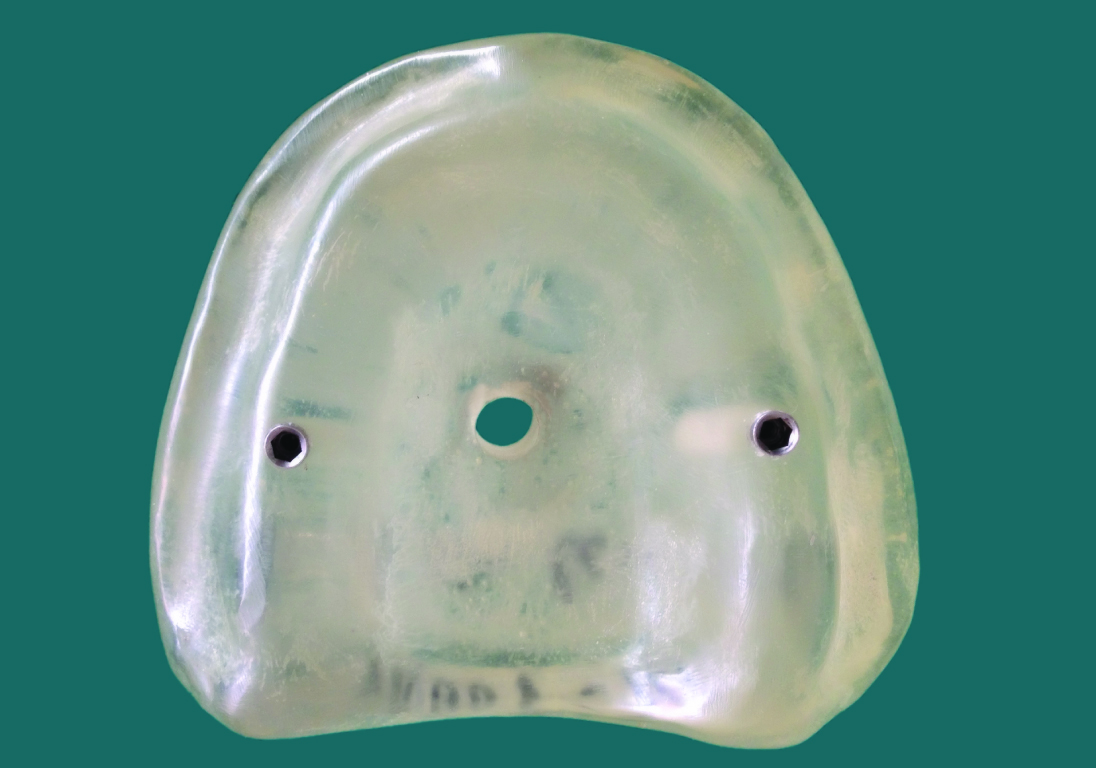
Implant abutments screwed on implant analogs.
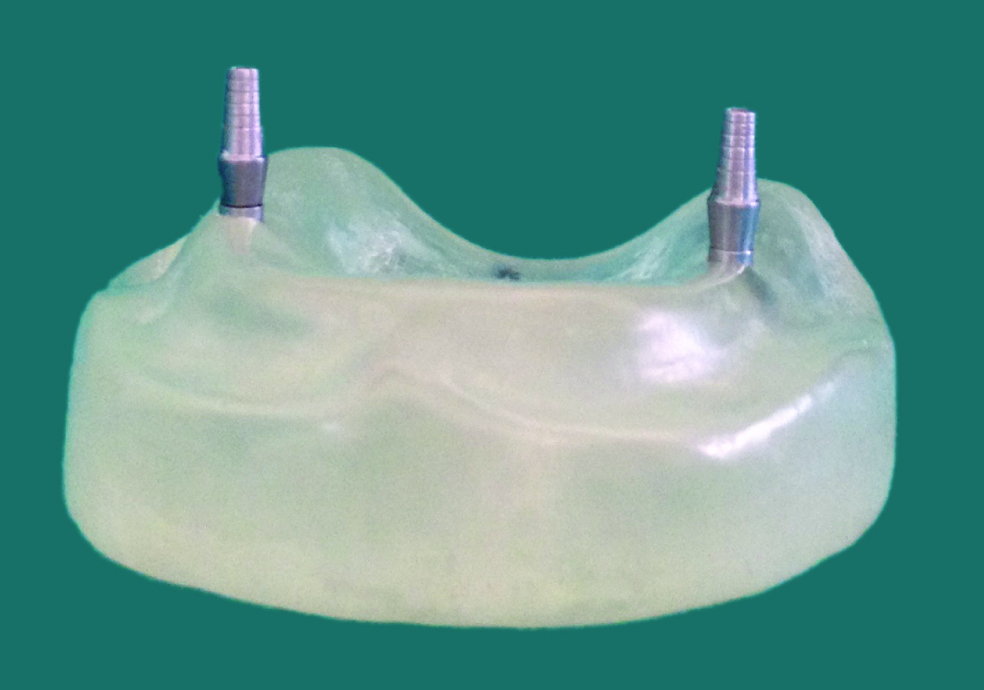
The access holes in the abutments were filled with cotton plug and sealed with clear autopolymerising acrylic resin (Rapid Repair, Pyrex, India). One layer of die spacer (Gold, 15μm, Duralon) was applied on the abutment 1mm short of the margin with help of brush and was allowed to dry. After that, one layer of die lubricant was applied with help of brush and allowed to dry. Wax pattern of a crown was made with inlay wax (Bego, Germany). An 8mm diameter loop of wax was added to the occlusal surface of each crown for retention test. The wax patterns were invested in a phosphate-bonded investment (Bellavest®, Bego, Germany) and casting was done in non-precious metal alloy (Wiron® 99, Bego, Germany) in the induction casting machine (Bego, Germany). The castings were evaluated and adjusted, if any and the metal crowns were finished, polished and cemented [Table/Fig-5].
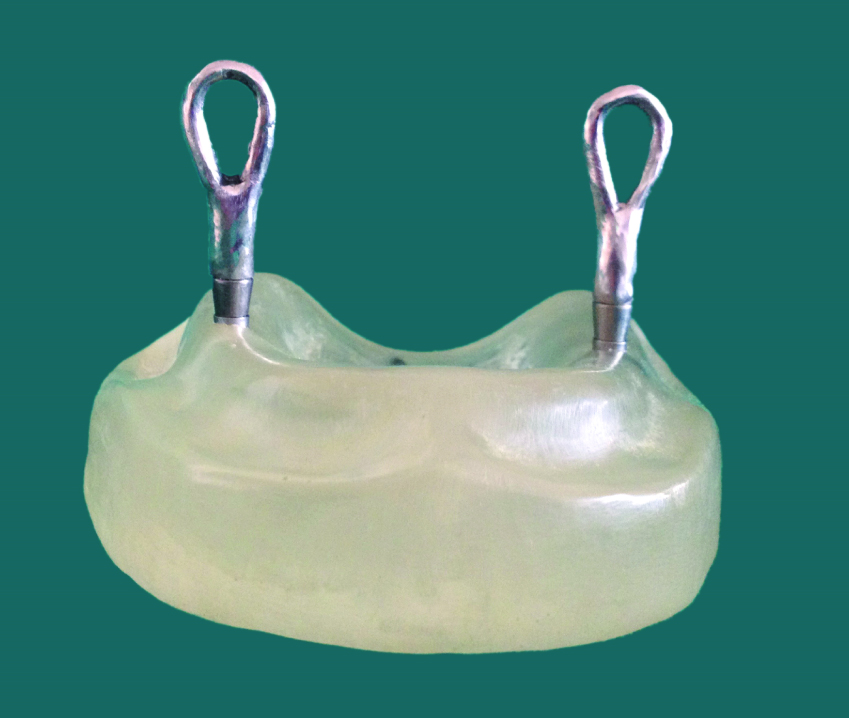
Cemented crowns were pulled off with a crosshead speed of 1mm/min, and the maximum force to debond each crown was considered as retentive strength [Table/Fig-6] as mentioned in [Table/Fig-7]. Data thus obtained was put to statistical analysis (One-way ANOVA and Post-hoc Tukey test) and graph was plotted [Table/Fig-8].
Testing of cemented crowns on universal testing machine
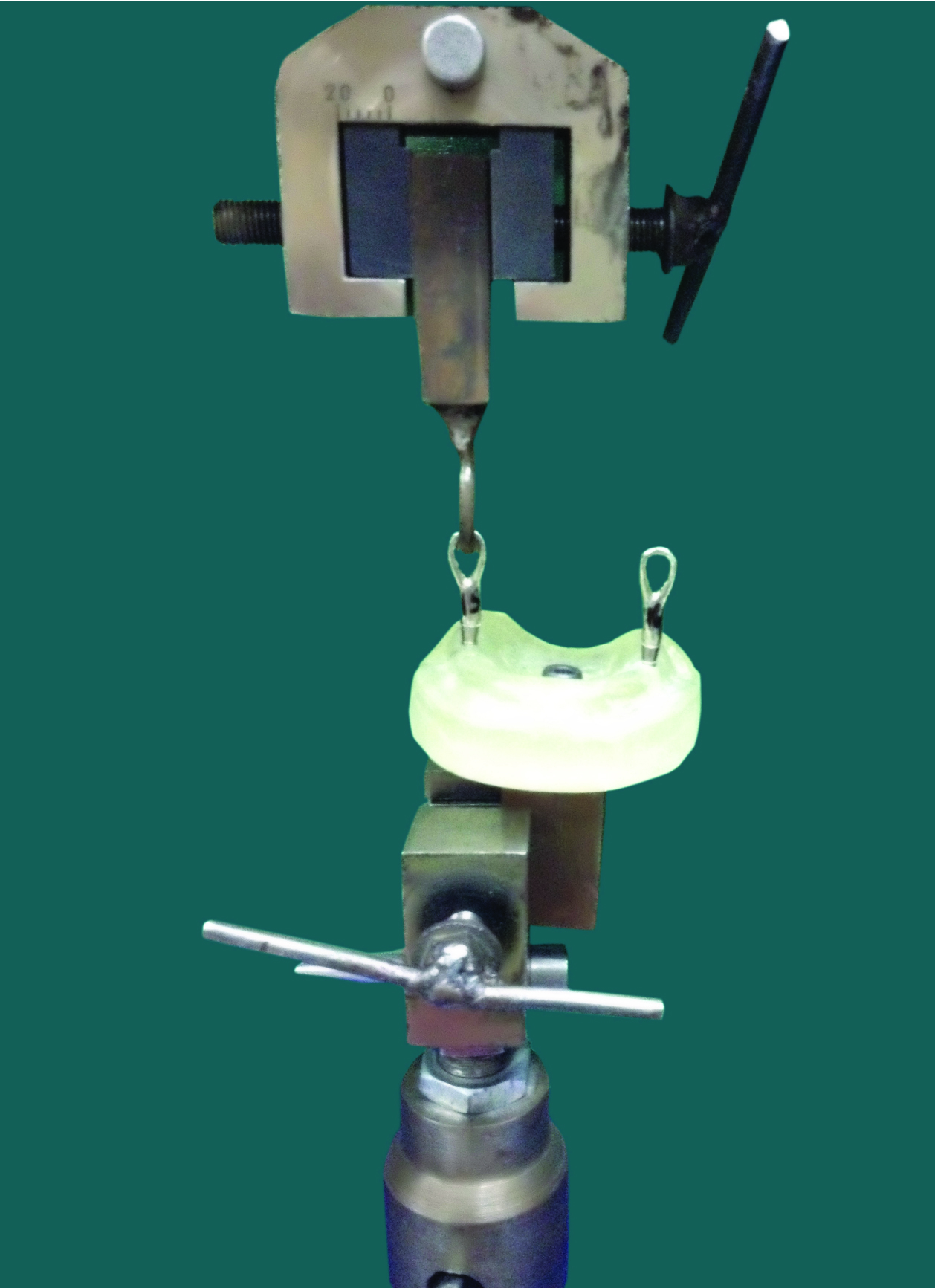
Showing the retentive strength for different groups.
| Group | N | Range | Mean ± SD | 95% CI |
|---|
| I-Zinc Phostphate | 20 | 460.0 – 594.6 | 529.480 ± 35.861 | 512.696 – 546.263 |
| II-Resin modified GIC | 20 | 274.5 – 381.7 | 338.095 ± 31.098 | 323.540 – 352.649 |
| III-Resin | 20 | 539.4 – 627.1 | 581.075 ± 21.552 | 570.988 – 591.161 |
| IV-ImProv | 20 | 224.8 – 276.6 | 249.045 ± 14.876 | 242.082 – 256.007 |
| V-Premier | 20 | 133.4 – 150.5 | 140.490 ± 4.832 | 138.228 – 142.751 |
ANOVA: p<0.001; Highly significant.
Mean resistance (Newtons) in all groups
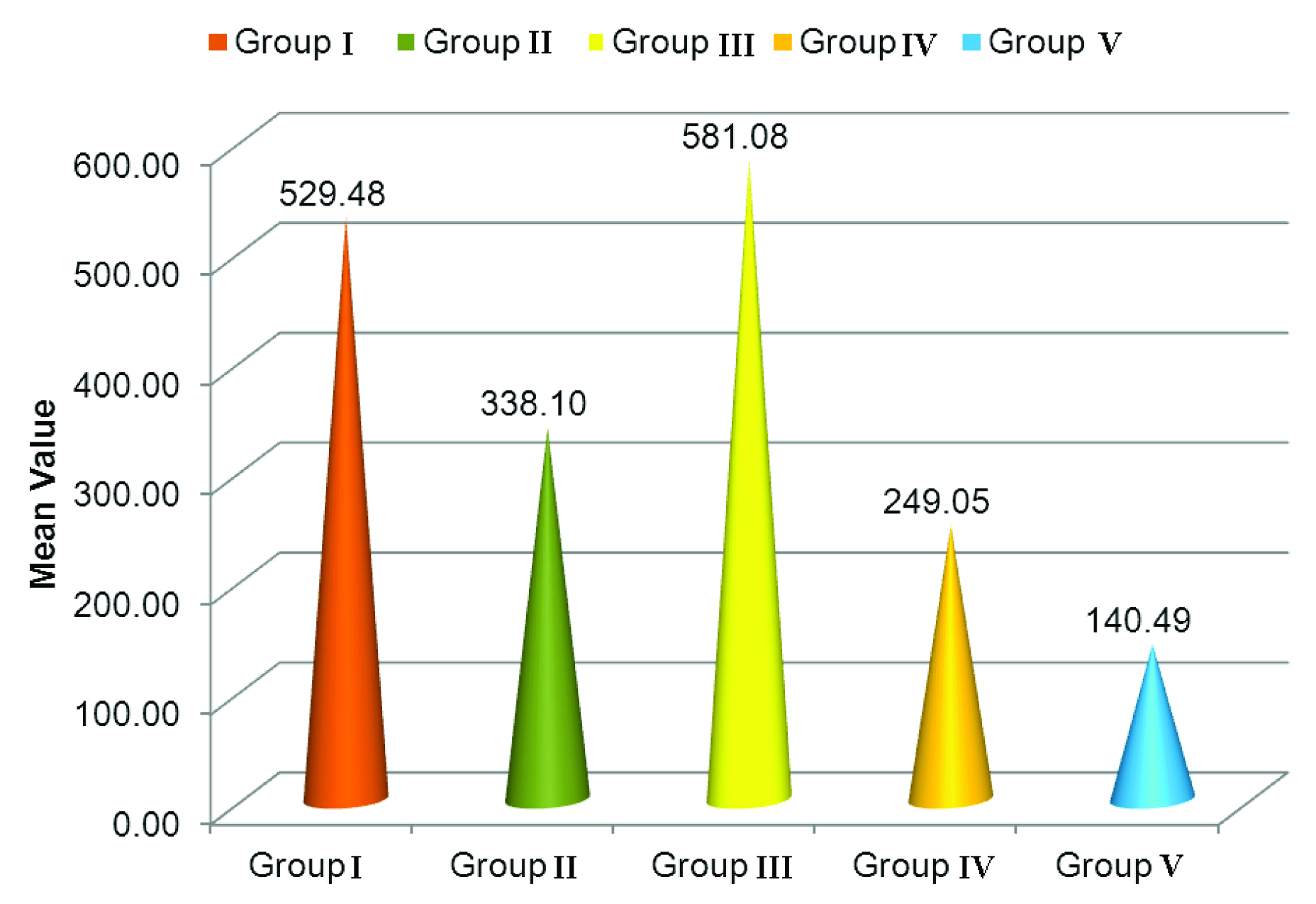
Results
In group I mean retentive strength was 529.480±35.861 with range of 460.0 – 594.6. In group II mean retentive strength was 338.095±31.098 with range of 274.5 – 381.7. In group III mean retentive strength was 581.075±21.552 with range of 539.4 – 627.1. In group IV mean retentive strength was 249.045 ± 14.876 with range of 224.80 – 276.06. In group V mean retentive strength was 140.490 ± 4.832 with range of 133.4 – 150.5 [Table/Fig-7].
Comparing mean retentive strength among five groups using one-way ANOVA, F value came out to be 1166.993 and p-value was <0.001 which was highly significant. When each group was compared with other using Post-Hoc Tukey HSD, it showed that the mean difference between retentive strength of all the five groups was highly significant with p-value of <0.001[Table/Fig-9].
Post-Hoc Multiple Comparisons Test.
| Comparison | Mean Difference | p-value |
|---|
| Zinc Phosphate vs Resin modifed GIC | 191.38 | <0.001** |
| Zinc Phosphate Resin | 51.59 | <0.001** |
| Zinc Phosphate vs ImProv | 280.43 | <0.001** |
| Zinc Phosphate vs Premier | 388.99 | <0.001** |
| | |
| Resin modifed GIC vs Resin | 242.98 | <0.001** |
| Resin modifed GIC vs ImProv | 89.05 | <0.001** |
| Resin modifed GIC vs Premier | 197.60 | <0.001** |
| | |
| Resin vs ImProv | 332.03 | <0.001** |
| Resin vs Premier | 440.58 | <0.001** |
| | |
| ImProv vs Premier | 108.55 | <0.001** |
**p<0.001; Highly significant.
Discussion
Cement retained implant-supported prostheses are routinely used in dentistry. This approach resembles conventional prosthodontics procedures [6]. Superior occlusion, reduced cost, reduced complexity of components and laboratory procedures and reduced chair-side time are the additional benefits [3].
The highest retentive strength of resin cement may be due to the reason that it is a self-adhesive resin cement [Table/Fig-7]. It forms an adhesive bond with the metal surface. Naturally formed oxide on the base metal surface also contributes to the bonding.
Non-eugenol temporary resin cement (Premier) is designed for implant-retained crowns and provisionals. It provides secure retention and excellent marginal seal. It is a very tough resin that uses mechanical retention to adhere the crown to the abutment. Yet, when desired, the restoration can be removed easily due to its unique elasticity. It had the lowest retentive strength [Table/Fig-7].
The results of the study are synonymous with results of a study conducted by Pan YH et al., in which he concluded resin cement had highest retention value with non-eugenol acrylic based temporary implant cement being the submaximal [7].
The results of the study are synonymous with the results of a study conducted by Pan YH in which he concluded that non-eugenol acrylic based temporary cement had retention value less than that of zinc phosphate cement [8].
The results of present study are contradictory with the study conducted by Montenegro AC et al., in which he compared the retention of glass ionomer, zinc phosphate, zinc oxide eugenol and resin cement and it was found that zinc phosphate had the highest retention among all [9].
The results of a study conducted by Bernal G et al., were dissimilar to present study in which he compared the retention of zinc phosphate, zinc oxide eugenol and acrylic based temporary implant cement. He concluded that acrylic based temporary implant cement had the highest retention value [10].
Nejatidanesh et al., evaluated the retention values of implant-supported metal copings using different luting agents. He concluded that the resin modified glass ionomer, zinc phosphate, zinc polycarboxylate and resin a cement are recommended for definitive cementation of single implant-supported restorations. The provisional cements and glass ionomer may allow retrievability of these restorations [11].
Hence, the results of the present study showed that resin cement has the highest retentive strength followed by zinc phosphate, resin-modified glass ionomer cement, non-eugenol acrylic based temporary implant cement and non-eugenol temporary resin cement.
Limitation
No humidor was used, nor was thermocycling accomplished so; the effects of degradation that might be seen in the clinical situation over time were not taken into account in the study. Even so, the general concurrence with findings of other studies allows us to conclude that the rank ordering of the cements is valid, if not the absolute values of retention.
Castings in this study were made from a base metal alloy, had a precious metal alloy, titanium, or some other material been used results may have varied.
Conclusion
Within the limitations of study, it was concluded that non-eugenol acrylic based temporary implant cement and non-eugenol temporary resin implant cement allow for easy retrievability of the prosthesis in case of any failure in future. These are suitable for cement retained implant restorations. The results of this study provide a possible preliminary ranking of luting agents based on their ability to retain an implant-supported prosthesis and facilitate easy retrieval.
ANOVA: p<0.001; Highly significant.**p<0.001; Highly significant.